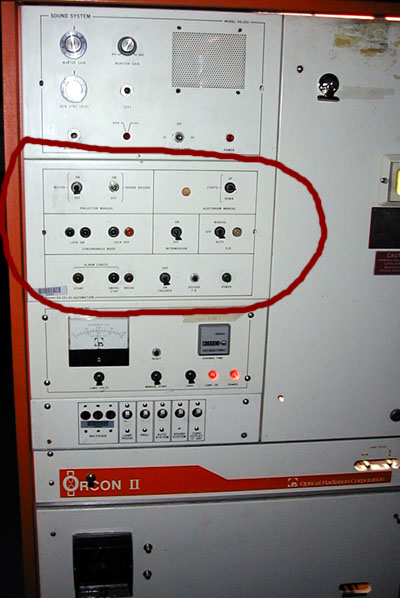|
|
This topic comprises 2 pages: 1 2
|
|
Author
|
Topic: Start Cue for ORC Automation?
|
|
|
|
|
|
|
|
|
|
|
|
|
|
|
|
|
|
|
|
|
|
|
|
|
|
|
|
|
Brad Miller
Administrator

Posts: 17775
From: Plano, TX (36.2 miles NW of Rockwall)
Registered: May 99
|
 posted 08-29-2002 02:15 PM
posted 08-29-2002 02:15 PM




Wes, it is because it is unprofessional. I say unprofessional meaning that if you are threading up a mere 7 seconds of film away from the first frame of your presentation, you are basically getting on your hands and knees and begging to the gods of dirt to come live on your film...especially that first trailer. The dirt that gets on the leader (moreso at theaters where they let the leader touch the floor as they thread) then transfers itself to the next wrap on the center ring as it is taken up. Then the next show that second layer of dirty film transfers it's dirt to the third layer, then the fourth, then the fifth and so on. This is why at probably over 90% of all theaters, the first trailer looks awful, and then slowly clears up the further into the roll of film the show gets. A professional operation's "first trailer on the platter" after weeks of running will look just as good as the middle of a 2000 foot reel of the feature on it's first run. Then there's the issue of threading on a reasonable length of leader (never ever less than 50 feet, 75 or 100 is preferred) and "motoring down" to the start point. Turning that motor switch on and off is just adding more wear and tear to the motor and gears. A start cue is the professional way to go for both your equipment and your presentation.
| IP: Logged
|
|
|
|
All times are Central (GMT -6:00)
|
This topic comprises 2 pages: 1 2
|
Powered by Infopop Corporation
UBB.classicTM
6.3.1.2
The Film-Tech Forums are designed for various members related to the cinema industry to express their opinions, viewpoints and testimonials on various products, services and events based upon speculation, personal knowledge and factual information through use, therefore all views represented here allow no liability upon the publishers of this web site and the owners of said views assume no liability for any ill will resulting from these postings. The posts made here are for educational as well as entertainment purposes and as such anyone viewing this portion of the website must accept these views as statements of the author of that opinion
and agrees to release the authors from any and all liability.
|

 Home
Home
 Products
Products
 Store
Store
 Forum
Forum
 Warehouse
Warehouse
 Contact Us
Contact Us




 Printer-friendly view of this topic
Printer-friendly view of this topic


















